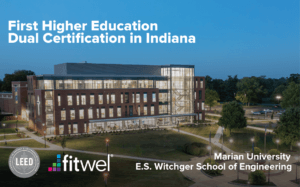
May 14, 2024 | Written by Daniel Overbey
Marian University and the project team for the E.S. Witchger School of Engineering building achieved Fitwel certification this past November. Having recently earned LEED Silver certification, this is the first higher education building in the State of Indiana to achieve both certifications.
The new School of Engineering building represents a significant milestone in the university’s commitment to enhance the learning experience for its students while embodying Marian University’s Franciscan values and mission to uplift the creativity, science, and exploration of the STEHM programs became the design objective.
As such, when Browning Day began our partnership with Marian University, through our first stages of the design process it became clear that the facility must provide state-of-the-art teaching lab spaces as well as high-tech classrooms, collaborative learning spaces, and support areas to help address the school’s need for appropriate learning spaces in this growing field of study. Our project team realized the E.S. Witchger School of Engineering ‘s ethos of high-performance should permeate all aspects of the design and construction of the new facility. The university agreed. The facility itself embodies high-performance in architecture, engineering, and construction.
Born out of this charge was a very unique goal: the E.S. Witchger School of Engineering shall achieve third-party certification for environmentally environmental responsibility, energy efficiency, and healthy indoor environments. The project team set out to become the first higher education facility in Indiana to ever achieve both *LEED and *Fitwel certification.
What does the Fitwel certification entail for this project?
The following are the high-scoring elements of this building:
- Site Selection = pedestrian-friendly location with multiple access to sidewalks and public transit stops.
- Outdoor Amenity Spaces = restorative garden, walking trail, sports facilities.
- Stairs = highly visible, well-designed stair encourages movement through the building.
- Indoor Environment = Enhanced indoor air quality measures including ventilation, pest management, healthy cleaning practices, non-smoking building.
- Shared Indoor Amenity Spaces = break areas, quiet room, lactation room, access to exercise facilities on campus.
- Water Supply = providing free access to filtered water and bottle filling throughout the building.
The result of the collective effort is considerable – and serves as a testament to the sound investment of green building. The 107,000-square-foot facility is nearly 20% more energy-efficient than what Indiana’s energy code requires, saving the university nearly $70,000 per year (a savings that will only increase as energy costs continue to rise). This level of energy efficiency was achieved through high-performance building envelope assemblies, lighting specifications, and mechanical systems solutions. The School of Engineering does not contain a permanent irrigation system and the building was designed to reduce indoor water requirements by at least 36%. Environmentally preferable building products and materials were utilized throughout the project, with special attention given to selections that could improve indoor environmental quality to ensure healthy indoor spaces for users of the building.
Third-party certified green buildings better ensure a building owner gets what they think they’re paying for. Across our higher education portfolio, LEED-certified projects yield direct operational cost savings of 39 cents per square foot per year, and that number rises. That only accounts for direct operational cost savings; Fitwel certified buildings offer a tremendous opportunity for indirect savings through the improved health and wellness of building occupants.
*What is LEED?
LEED (Leadership in Energy and Environmental Design) is a globally recognized green building certification program that serves as the benchmark for the design, construction, and operation of high-performance green buildings. Developed by the U.S. Green Building Council (USGBC), LEED provides independent verification of a building’s sustainability attributes, ranging from energy-efficiency, to water usage, to indoor environmental quality, and material selection.
Learn more at www.usgbc.org/leed
*What is Fitwel?
Fitwel is a leading global health certification system that provides evidence-based strategies to enhance building environments and improve health outcomes for occupants. Developed by the U.S. Centers for Disease Control and Prevention (CDC) and the General Services Administration (GSA), and operated by the Center for Active Design, Fitwel is pioneering the movement toward healthier workplace environments through its rigorous assessment of workplace design and policies. The certification process evaluates all aspects of health, from air quality to nutritional options, aiming to foster a more productive and health-driven workspace.
Learn more about Fitwel at www.fitwel.org